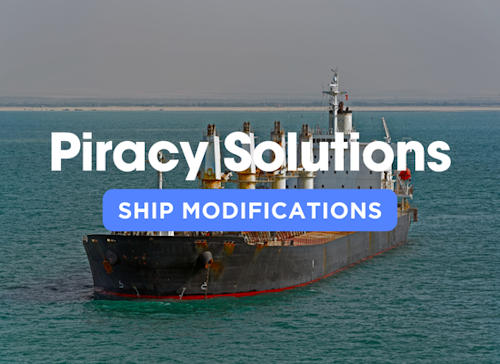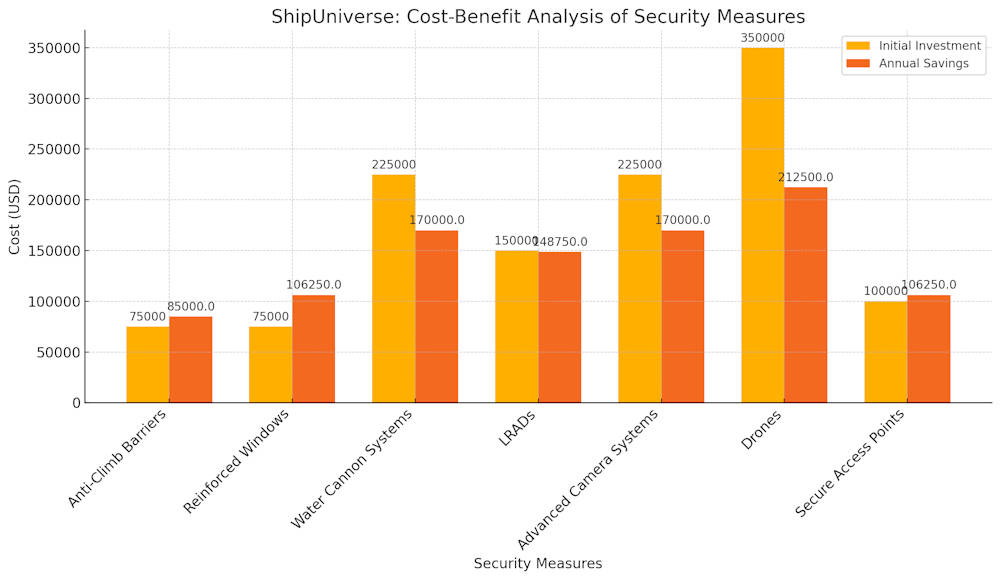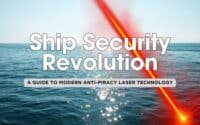Innovative Ship Modifications to Combat Piracy

Given the persistent threat of piracy, it is crucial for ship owners and operators to implement effective deterrent measures. By modifying ships to make them less attractive and more difficult targets, shipping companies can significantly reduce the risk of pirate attacks. These modifications not only enhance the safety of the crew but also protect valuable cargo and maintain the integrity of maritime operations.
Below we explore various ship modifications that can deter pirate attacks. It will cover both new builds and retrofits for existing ships, providing practical solutions and real-world examples to help ship owners enhance their security measures.
Understanding the Pirate Threat
Current Piracy Hotspots and Trends
Maritime piracy is most prevalent in specific regions known as piracy hotspots. These areas include:
- Gulf of Guinea: This region off the west coast of Africa is notorious for violent pirate attacks targeting oil tankers and cargo ships.
- Somali Coast: Despite a decline in activity, Somali pirates still pose a threat to vessels passing through the Gulf of Aden.
- Southeast Asia: The Malacca Strait and surrounding waters see frequent incidents of piracy, often involving hijacking and cargo theft.
Common Tactics and Methods Used by Modern Pirates
Modern pirates employ a variety of tactics to hijack ships and capture crew members:
- Speedboats: Pirates use fast, maneuverable boats to approach and board ships quickly.
- Boarding Ladders: They use ladders to climb onto the ship from the side, often targeting areas with lower freeboards.
- Firearms and Hostage Taking: Pirates are typically armed with guns and other weapons, using force to intimidate and control the crew.
- Ransom Demands: After hijacking, pirates often demand large ransoms for the release of the ship and crew.
Impact of Piracy on Shipping Operations and Global Trade
The impact of maritime piracy is far-reaching and affects multiple aspects of global trade:
- Increased Shipping Costs: Shipping companies face higher insurance premiums and security expenses due to the risk of piracy.
- Disruption of Supply Chains: Piracy can delay shipments and disrupt supply chains, leading to financial losses for businesses dependent on timely deliveries.
- Humanitarian Concerns: Crew members are at risk of injury, kidnapping, or even death during pirate attacks, highlighting the need for enhanced security measures.
- Economic Losses: The global economy suffers as piracy disrupts trade routes, leading to increased costs for goods and services.

Modifications for New Builds
Design Considerations
Streamlined Hull Designs to Reduce Boarding Opportunities
- Smooth Hull Surfaces: By designing ships with smoother and more streamlined hull surfaces, boarding becomes more challenging for pirates who rely on grappling hooks and ladders to climb aboard.
- High Freeboard: Increasing the freeboard, or the height of the ship’s deck above the waterline, makes it more difficult for pirates to scale the sides of the vessel.
Elevated Bridge and Living Quarters for Better Surveillance and Security
- Raised Bridge: Positioning the ship’s bridge at a higher elevation provides a better vantage point for monitoring the surrounding area, enabling the crew to spot potential threats from a greater distance.
- Secure Living Quarters: Placing the crew’s living quarters in elevated and more secure sections of the ship reduces the risk of pirates gaining access and taking hostages.
Integrated Defense Systems
Water Cannon Systems: Positioning and Effectiveness
- Strategic Placement: Water cannons should be strategically placed around the ship to cover all potential boarding points, including the sides and stern.
- High-Pressure Jets: Utilizing high-pressure water jets can effectively deter pirates by making it difficult for them to approach and board the ship. These systems can be automated to activate when unauthorized vessels are detected nearby.
Sonic Deterrent Devices: Types and Implementation
- Long-Range Acoustic Devices (LRADs): These devices emit powerful sound waves that can disorient and repel pirates. LRADs can be mounted on the deck and directed towards approaching threats.
- Sound Frequency Modulation: Using a range of sound frequencies, sonic deterrent devices can cause discomfort and confusion among attackers, discouraging them from continuing their approach.
Enhanced Surveillance Technology
Advanced Radar and Sonar Systems
- 360-Degree Coverage: Modern radar and sonar systems should provide comprehensive 360-degree coverage around the ship to detect and track potential pirate vessels.
- Integration with Security Systems: Linking radar and sonar data with the ship’s security systems allows for real-time threat assessment and automatic activation of defensive measures.
Automated Drone Surveillance and Response Units
- Aerial Drones: Deploying drones equipped with cameras and sensors can extend the ship’s surveillance range, allowing for early detection of pirate vessels from the air.
- Autonomous Response: Drones can be programmed to autonomously patrol the ship’s vicinity, providing continuous monitoring and alerting the crew to any suspicious activities.
Secure Access Points
Reinforced Doors and Hatches
- Steel Reinforcement: Using steel-reinforced doors and hatches can prevent unauthorized entry and withstand attempts to break through.
- Multiple Locking Mechanisms: Implementing multiple locking mechanisms, including deadbolts and electronic locks, enhances the security of access points.
Electronic Access Control and Biometric Systems
- Access Cards and Keypads: Installing electronic access control systems with keypads or access card readers ensures that only authorized personnel can enter secure areas of the ship.
- Biometric Verification: Utilizing biometric systems, such as fingerprint or retinal scanners, provides an additional layer of security by verifying the identity of individuals before granting access.
Modifications for New Builds
Design Considerations
Streamlined Hull Designs to Reduce Boarding Opportunities
- Smooth Hull Surfaces: By designing ships with smoother and more streamlined hull surfaces, boarding becomes more challenging for pirates who rely on grappling hooks and ladders to climb aboard.
- High Freeboard: Increasing the freeboard, or the height of the ship’s deck above the waterline, makes it more difficult for pirates to scale the sides of the vessel.
Elevated Bridge and Living Quarters for Better Surveillance and Security
- Raised Bridge: Positioning the ship’s bridge at a higher elevation provides a better vantage point for monitoring the surrounding area, enabling the crew to spot potential threats from a greater distance.
- Secure Living Quarters: Placing the crew’s living quarters in elevated and more secure sections of the ship reduces the risk of pirates gaining access and taking hostages.
Integrated Defense Systems
Water Cannon Systems: Positioning and Effectiveness
- Strategic Placement: Water cannons should be strategically placed around the ship to cover all potential boarding points, including the sides and stern.
- High-Pressure Jets: Utilizing high-pressure water jets can effectively deter pirates by making it difficult for them to approach and board the ship. These systems can be automated to activate when unauthorized vessels are detected nearby.
Sonic Deterrent Devices: Types and Implementation
- Long-Range Acoustic Devices (LRADs): These devices emit powerful sound waves that can disorient and repel pirates. LRADs can be mounted on the deck and directed towards approaching threats.
- Sound Frequency Modulation: Using a range of sound frequencies, sonic deterrent devices can cause discomfort and confusion among attackers, discouraging them from continuing their approach.
Enhanced Surveillance Technology
Advanced Radar and Sonar Systems
- 360-Degree Coverage: Modern radar and sonar systems should provide comprehensive 360-degree coverage around the ship to detect and track potential pirate vessels.
- Integration with Security Systems: Linking radar and sonar data with the ship’s security systems allows for real-time threat assessment and automatic activation of defensive measures.
Automated Drone Surveillance and Response Units
- Aerial Drones: Deploying drones equipped with cameras and sensors can extend the ship’s surveillance range, allowing for early detection of pirate vessels from the air.
- Autonomous Response: Drones can be programmed to autonomously patrol the ship’s vicinity, providing continuous monitoring and alerting the crew to any suspicious activities.
Secure Access Points
Reinforced Doors and Hatches
- Steel Reinforcement: Using steel-reinforced doors and hatches can prevent unauthorized entry and withstand attempts to break through.
- Multiple Locking Mechanisms: Implementing multiple locking mechanisms, including deadbolts and electronic locks, enhances the security of access points.
Electronic Access Control and Biometric Systems
- Access Cards and Keypads: Installing electronic access control systems with keypads or access card readers ensures that only authorized personnel can enter secure areas of the ship.
- Biometric Verification: Utilizing biometric systems, such as fingerprint or retinal scanners, provides an additional layer of security by verifying the identity of individuals before granting access.
Retrofits for Existing Ships
Structural Reinforcements
Adding Anti-Climb Barriers and Razor Wire
- Anti-Climb Barriers: Installing barriers along the perimeter of the ship, particularly in areas prone to boarding attempts, can make it significantly harder for pirates to climb aboard. These barriers can be designed with smooth, angled surfaces that are difficult to grip.
- Razor Wire: Deploying razor wire around the ship’s deck and along the sides acts as a physical deterrent. Razor wire is a cost-effective solution that can be quickly installed and provides an immediate obstacle to boarding attempts.
Installing Reinforced Windows and Bulkheads
- Shatterproof Windows: Replacing standard windows with shatterproof or bulletproof glass enhances the security of critical areas like the bridge and living quarters. These windows can withstand impacts and prevent entry.
- Reinforced Bulkheads: Strengthening bulkheads, especially in areas where crew members can take refuge, ensures that these compartments can resist forced entry and provide safe zones during an attack.
Non-Lethal Defense Mechanisms
Deployable Water Hoses and Foam Spray Systems
- Water Hoses: Installing high-pressure water hoses at strategic points around the ship can be an effective deterrent against boarding. These hoses can be manually operated or set up with automated triggers to respond to unauthorized approach.
- Foam Spray Systems: Using foam spray systems to create a slippery and hazardous surface can make it difficult for pirates to maintain their footing and proceed with boarding attempts. The foam can also obscure vision and disrupt coordination among attackers.
Long-Range Acoustic Devices (LRAD) for Crowd Control
- LRAD Deployment: Retrofitting ships with LRADs allows for non-lethal crowd control by emitting intense sound waves that cause discomfort and disorientation. These devices can be used to target approaching vessels and deter boarding attempts.
- Directional Sound Beams: LRADs can emit highly directional sound beams that affect only the targeted area, minimizing disruption to the ship’s crew while effectively repelling attackers.
Upgraded Surveillance Systems
Retrofitting Ships with Advanced Camera Systems
- Comprehensive Coverage: Installing a network of high-resolution cameras around the ship provides continuous monitoring of all vulnerable points. These cameras should be equipped with night vision and thermal imaging capabilities to ensure visibility in all conditions.
- Centralized Monitoring: Integrating camera feeds into a centralized monitoring system on the bridge allows for real-time surveillance and quick response to potential threats. The system can also include motion detection and alert features.
Integration of Thermal Imaging and Night Vision Capabilities
- Thermal Cameras: Adding thermal imaging cameras enhances the ship’s ability to detect unauthorized vessels and individuals in low-visibility conditions, such as at night or in fog.
- Night Vision Goggles: Providing the crew with night vision goggles ensures that they can maintain situational awareness during nighttime operations and respond effectively to threats.
Communication Enhancements
Secure, Encrypted Communication Channels
- Encryption Protocols: Implementing secure communication protocols ensures that all ship-to-shore and ship-to-ship communications are encrypted, preventing eavesdropping and interception by pirates.
- Dedicated Emergency Channels: Establishing dedicated communication channels for emergency situations allows for rapid coordination with maritime security forces and other ships in the vicinity.
Panic Buttons and Direct Lines to Maritime Security Forces
- Panic Buttons: Installing panic buttons at key locations on the ship enables crew members to quickly alert the bridge and security forces in the event of a pirate attack.
- Direct Lines: Setting up direct communication lines with maritime security agencies ensures that help can be summoned immediately in case of an emergency. This includes satellite phones and radio frequencies reserved for distress calls.
Cost-Benefit Analysis
Initial Investment vs. Long-Term Savings
Upfront Costs
- Structural Modifications: Investing in anti-climb barriers, reinforced windows, and secure access points may require a significant initial outlay.
- Example: Installing shatterproof windows can cost between $50,000 and $100,000 depending on the size and number of windows.
- Technology Upgrades: Implementing advanced surveillance systems, water cannons, and LRADs also involves substantial upfront expenses.
- Example: A comprehensive camera system with night vision and thermal imaging capabilities might cost around $150,000 to $300,000.
- Retrofit Costs: For existing ships, retrofitting costs can vary based on the extent of the modifications needed.
- Example: Adding water hose systems and automated drones could range from $200,000 to $500,000.
Long-Term Savings
- Reduced Insurance Premiums: Enhanced security measures often lead to lower insurance premiums due to the reduced risk of piracy.
- Example: Ships with advanced security can see insurance premium reductions of 10-20%, potentially saving hundreds of thousands of dollars annually.
- Lower Ransom Payments: Effective deterrence measures reduce the likelihood of hijackings and subsequent ransom demands.
- Example: Avoiding a single ransom payment, which can range from $500,000 to several million dollars, significantly offsets initial security investments.
- Minimized Operational Disruptions: Preventing pirate attacks ensures uninterrupted operations, reducing the costs associated with delays and rerouting.
- Example: Avoiding delays can save tens of thousands of dollars per day in operational costs.
Potential Reduction in Ransom Payments and Recovery Costs
Impact of Effective Deterrence
- Deterring Attacks: Ships equipped with robust security measures are less likely to be targeted by pirates, reducing the frequency and severity of ransom situations.
- Example: A vessel that avoids capture can save millions in potential ransom payments and negotiation costs.
- Swift Recovery: In the rare event of a successful boarding, enhanced communication and rapid response systems facilitate quicker recovery and rescue operations.
- Example: Quick response can reduce the duration of captivity and associated costs by thousands of dollars.
Enhanced Safety and Peace of Mind for Crew Members
Crew Morale and Retention
- Safety Measures: Implementing comprehensive security modifications not only protects the ship but also significantly enhances the safety of crew members.
- Example: Elevated crew morale and a sense of security lead to higher retention rates and reduced turnover costs.
- Training and Preparedness: Providing crew members with training on new security systems and emergency protocols further boosts confidence and operational readiness.
- Example: Well-trained crews are better prepared to handle piracy threats, reducing the likelihood of successful attacks.
Summary of Financial Benefits
Comprehensive Savings Overview
- Insurance Premium Reductions: Lower premiums due to decreased risk.
- Ransom and Recovery Cost Avoidance: Significant savings by preventing hijackings.
- Operational Efficiency: Minimizing disruptions and maintaining smooth operations.
Return on Investment (ROI)
- Short Payback Period: The combined savings on insurance, operational efficiency, and avoided ransom payments often result in a short payback period for the initial investment.
- Example: Many ship owners report recouping their investment within 2-3 years through cost savings and enhanced security.
By conducting a thorough cost-benefit analysis, it becomes clear that the initial investment in ship modifications for security purposes yields substantial long-term financial benefits. These enhancements not only protect valuable assets but also ensure the safety and well-being of crew members, contributing to overall operational success and sustainability in piracy-prone waters.
Future Innovations in Ship Security
Emerging Technologies and Research in Maritime Security
Autonomous Security Systems
- Automated Drones: Development of fully autonomous drones that can patrol the ship’s perimeter, conduct surveillance, and respond to potential threats without human intervention.
- Features: Real-time video feed, thermal imaging, and AI-driven threat detection.
- Benefits: Continuous monitoring, rapid response to suspicious activities, and reduced reliance on human operators.
AI and Machine Learning
- Predictive Analytics: Utilizing AI and machine learning to analyze vast amounts of data from various sources (e.g., weather patterns, historical pirate activity) to predict and preempt potential pirate threats.
- Applications: Route planning, risk assessment, and automated alert systems.
- Benefits: Enhanced decision-making, reduced likelihood of encountering pirate hotspots, and improved operational efficiency.
Advanced Defense Mechanisms
- Non-Lethal Laser Systems: Development of non-lethal laser deterrents that can temporarily incapacitate pirates without causing permanent harm.
- Features: Blinding lasers, disorienting flashes.
- Benefits: Effective at repelling attackers while minimizing harm, compliance with international regulations regarding the use of force.
Potential Future Modifications and Defense Systems
Hybrid Defense Systems
- Integrated Solutions: Combining various defense mechanisms into a unified system that can automatically deploy appropriate responses based on the nature of the threat.
- Components: Water cannons, sonic deterrents, laser systems, and automated drones.
- Benefits: Comprehensive protection, reduced human error, and streamlined defense operations.
Cybersecurity Enhancements
- Quantum Encryption: Implementing quantum encryption technologies to secure ship communications and data against increasingly sophisticated cyber threats.
- Features: Unbreakable encryption keys, real-time data protection.
- Benefits: Enhanced security for sensitive information, protection against cyber-attacks that could facilitate piracy.
Biometric and Behavioral Analytics
- Crew Monitoring Systems: Using biometric and behavioral analytics to continuously monitor crew members’ well-being and detect potential insider threats.
- Applications: Access control, real-time health monitoring, and anomaly detection.
- Benefits: Increased safety, early identification of suspicious behavior, and enhanced crew welfare.
Collaboration Between Shipbuilders, Security Experts, and Technology Providers
Joint Development Programs
- Collaborative Research: Encouraging joint research initiatives between shipbuilders, maritime security experts, and technology providers to develop innovative security solutions.
- Examples: Research grants, industry consortiums, and academic partnerships.
- Benefits: Accelerated innovation, sharing of expertise, and development of cutting-edge technologies.
Standardization and Best Practices
- Industry Standards: Establishing standardized guidelines and best practices for implementing ship security measures.
- Organizations Involved: International Maritime Organization (IMO), industry associations, and regulatory bodies.
- Benefits: Consistency in security measures, improved compliance, and enhanced global maritime security.
Training and Certification Programs
- Specialized Training: Developing training programs and certification courses for shipbuilders, security personnel, and crew members on the latest security technologies and practices.
- Content: Use of advanced defense systems, cybersecurity measures, and emergency response protocols.
- Benefits: Enhanced skills, improved preparedness, and higher standards of security across the maritime industry.
In the face of an ever-evolving threat from maritime piracy, it is imperative for ship owners and operators to adopt comprehensive security measures. By integrating advanced technologies and making strategic modifications to both new builds and existing vessels, the maritime industry can significantly enhance its defenses against pirate attacks. The insights and examples provided in this article highlight the importance of proactive measures, from structural reinforcements to cutting-edge surveillance and defense systems.
Investing in these security enhancements not only protects valuable assets and ensures the safety of crew members but also offers substantial financial benefits through reduced insurance premiums, minimized operational disruptions, and avoidance of costly ransom payments. As the industry continues to innovate and collaborate, the future of maritime security looks promising, with emerging technologies and standardized practices paving the way for safer and more resilient shipping operations.
Ultimately, the commitment to implementing effective piracy deterrents and staying ahead of evolving threats will safeguard global trade routes and contribute to the sustainable growth of the maritime industry. By taking these steps, ship owners can navigate piracy-prone waters with greater confidence and peace of mind, ensuring that their vessels and crew are well-protected against the dangers of the high seas.

Do you have a Maritime Product or Service that may be of interest to Shipowners? Tell us about it here!
Do you have feedback or insights? Please reach out to editor @ shipuniverse.com



